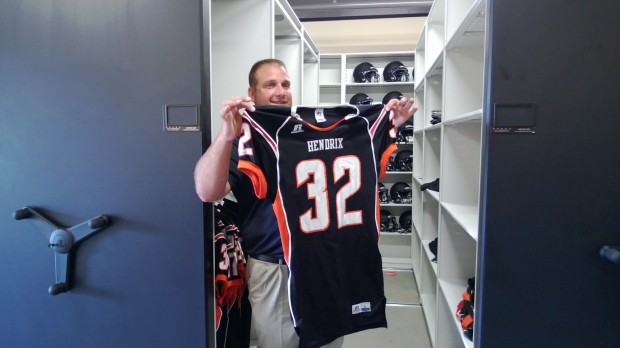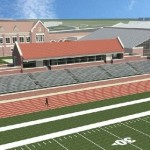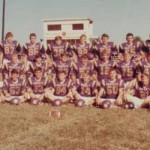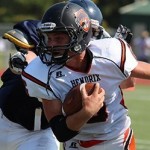Once Hendrix Warriors, Always Hendrix Warriors
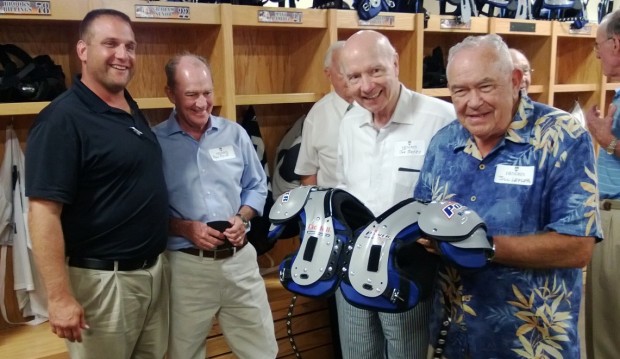
Coach Buck Buchanan in the new locker room with Hendrix Warriors alums (from left) Ron Pyle, Dr. Joe Bates and Bill Lefler
CONWAY – As Hendrix College prepares for its first intercollegiate football season in 53 years, it welcomed on Saturday numerous players from Hendrix Warriors teams of the 1950s and 60s for a luncheon in the Wellness and Athletics Center and tour of the stellar new facilities.
Between catching up, the assorted alumni cracked decades-old jokes at each other’s expense, a sure sign of the camaraderie of old teammates. But it did not take long for them to begin grilling new coach Buck Buchanan on this year’s squad, which opens the season Sept. 7 by hosting Westminster.
“We want to make something that all you guys can be proud of,” Buchanan said. “Things are going pretty well. I don’t know what that means in terms of wins and losses, but we’re trying to build something here over time. “
The coaching staff and nascent squad received effusive praise from athletic director Amy Weaver, who passed along stories of team members pushing a stalled car after leaving practice, as well as helping other incoming freshmen move furniture into the dorms.
“We clicked right away,” Weaver said of Buchanan. “The coaching staff is all men of great character. They will teach life lessons.”
Talk soon switched to roster size, recruiting, and Xs and Os. There are 56 Hendrix Warriors on this year’s team, which means depth is a concern, but getting reps for everyone is not.
“We have some talent, and every day they’re closer to being sophomores,” Buchanan said. “We’re throwing a lot at them. If you have 115 players, you’re not going to be able to evaluate all of them. It was crucial for us this year to start with small numbers.”
A trip through the state-of-the-art Sturgis Center revealed amenities unimaginable 15 years ago, let alone 50. The locker rooms, weight room, tape room and brand new uniforms proved impressive to the Hendrix alums.
The move to bring back football was not an instant hit, and many in the Hendrix community still oppose it. Even the Board of Trustees was skeptical in the beginning stages, and the former players provided some unique perspectives.
“The board had to be brought along,” said board member and former player Dr. Joe Bates. “At first there was a lot of pushback, especially from students who thought we would be lowering entrance standards. We said they had to meet the same standards. Then we had to find a way to fund all this, and people have contributed. Now there’s lots of excitement about what’s being built.”
Charles Tadlock, captain of the 1960 team that went 4-4-2, said, “Everyone was surprised. We didn’t understand that the college didn’t have the money to carry on the program. Some of my teammates never forgave the college, and have never been back on campus.”
The current team boasts an average ACT score of 27, and at least one board member recalls Hendrix teams from the past comparing favorably with the student body at large.
“I was against it at first, but then I was persuaded by the others,” said Bill Wilson, Federal Judge for the Eastern District of Arkansas and member of the 1960 team. “I attended a meeting of the student senate, and all but one of them was against (bringing back football) initially. I know that for our last team in 1960, the GPA was above the average of the student body.
“We had some really good athletes coming in for the ’61 season. We realize now the fiscal problems, but I really wish we had one more year.”
Physically, the campus was in a much different state in 1960 than it is today. With a campus that was fraught with buildings structurally unsound and in general disrepair, then-president Marshall Steel was tasked with making tough choices. Ultimately, varsity football ended up on the chopping block.
“I know Dr. Steel made a really hard decision,” said Gene Wilbourn, who played for Hendrix in the 50s, and returned later as a coach. “It was tough on everyone. It caught us by surprise. After reflecting on it for 10 years or so … our buildings were falling down. He had a lot of building to do, and it’s hard to go and ask for money when you’re spending money on the program.
“If he hadn’t been able to do that, I don’t think we would be where we are today.”
Though the pain of the loss of their team decades ago may have lessened, these senior Hendrix Warriors have not forgotten.
“After the last game, there were some tears shed in the parking lot, and it wasn’t the girls crying,” said Dan Robinson, a member of the 1960 team.



